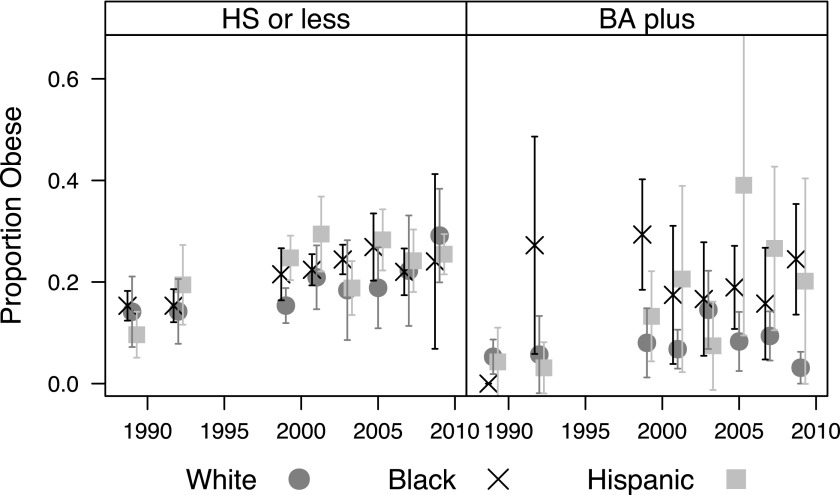Our recent paper (1) shows that, since 2002, obesity prevalence has declined among higher socio-economic status (SES) youth but continued to increase among lower SES youth. Gao et al. (2) posit that the relative increase in obesity in the low SES population could be explained by an increasing concentration of black youth in the lower SES group or other race/ethnicity factors.
Figure S3 from ref. 1 replicates the main simulation results on the National Health and Nutrition Examination Surveys (NHANES) sample restricted to non-Hispanic whites. Compared with figure 2 in ref. 1, which shows overall trends, figure S3 in ref. 1 shows that the obesity prevalence of white adolescents whose parents have no more than a high school degree increases faster, and the obesity prevalence of white teens whose parents have at least a 4-y college degree decreases faster. Thus, the class gap in adolescent obesity grows even faster among non-Hispanic whites than among the total adolescent population. In short, data presented with the original publication showed that the core finding of a growing class gap in adolescent obesity was not attributable to changing racial composition of the lower SES category, as Gao et al. suggest.
Running such simulations for non-Hispanic blacks, Hispanics, and the “other” race/ethnic category is problematic, because the sample size in each year × education category is often fewer than 30 observations, and hence the sampling error is extreme, as noted in the original paper. Fig. 1 shows the race-specific trends in obesity by parental education, and neither the non-Hispanic black nor the Hispanic trend lines are consistently significantly different from the non-Hispanic white trend line.
Fig. 1.
Trends in obesity among adolescents 12–17 y of age by race/ethnicity and parental education in the NHANES III, 1999–2010. Obesity is defined as being at or above the sex- and age-specific 95th percentile of the 2000 Centers for Disease Control and Prevention (CDC) growth charts. Error bars indicate 95% CIs. BA, Bachelors degree; HS, high school.
Moreover, we find a growing class gap in physical activity. We define adolescents who do not get at least 10 min of strenuous physical activity in the last 30 d as physically inactive. Gao et al. (2) note that “this level would not meet recommendations for a healthy physical activity level and would not have an effect on obesity rates.” Clearly, this is less than the recommended 60 min of physical activity per day, but we are limited by the data available. Nonetheless, there are not meaningful differences in caloric intake, whereas an increasing fraction of low SES youth are extremely sedentary. This suggests that it is physical activity, and not caloric intake, that is driving the growing youth class gap in obesity.
Supplementary Material
Footnotes
The authors declare no conflict of interest.
References
- 1.Frederick CB, Snellman K, Putnam RD. Increasing socioeconomic disparities in adolescent obesity. Proc Natl Acad Sci USA. 2014;111(4):1338–1342. doi: 10.1073/pnas.1321355110. [DOI] [PMC free article] [PubMed] [Google Scholar]
- 2.Gao Y, Gordon J, Sun W. Is poverty associated with obesity among American children? Proc Natl Acad Sci USA. 2014;111:E2237. doi: 10.1073/pnas.1405656111. [DOI] [PMC free article] [PubMed] [Google Scholar]



